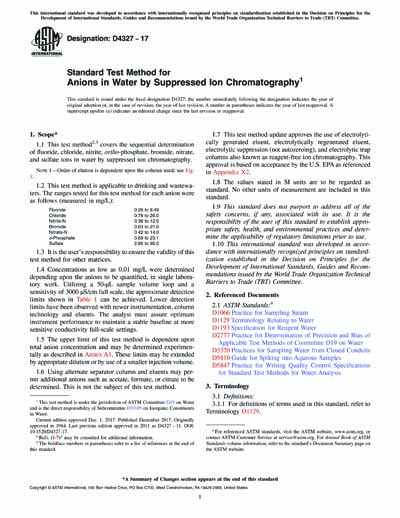Most recent
ASTM D4327-17
Standard Test Method for Anions in Water by Suppressed Ion Chromatography
1.1 This test method2,3 covers the sequential determination of fluoride, chloride, nitrite, ortho-phosphate, bromide, nitrate, and sulfate ions in water by suppressed ion chromatography.
Note 1: Order of elution is dependent upon the column used; see Fig. 1.
1.3 It is the user's responsibility to ensure the validity of this test method for other matrices.
1.4 Concentrations as low as 0.01 mg/L were determined depending upon the anions to be quantified, in single laboratory work. Utilizing a 50-μL sample volume loop and a sensitivity of 3000 μS/cm full scale, the approximate detection limits shown in Table 1 can be achieved. Lower detection limits have been observed with newer instrumentation, column technology and eluents. The analyst must assure optimum instrument performance to maintain a stable baseline at more sensitive conductivity full-scale settings.
Detector: as specified in 7.1.6.
Eluent: as specified in 8.3.
Pump rate: 2.0 mL/min.
Sample loop: 50 μL.
1.5 The upper limit of this test method is dependent upon total anion concentration and may be determined experimentally as described in Annex A1. These limits may be extended by appropriate dilution or by use of a smaller injection volume.
1.6 Using alternate separator column and eluents may permit additional anions such as acetate, formate, or citrate to be determined. This is not the subject of this test method.
1.7 This test method update approves the use of electrolytically generated eluent, electrolytically regenerated eluent, electrolytic suppression (not autozeroing), and electrolytic trap columns also known as reagent-free ion chromatography. This approval is based on acceptance by the U.S. EPA as referenced in Appendix X2.
1.8 The values stated in SI units are to be regarded as standard. No other units of measurement are included in this standard.
1.9 This standard does not purport to address all of the safety concerns, if any, associated with its use. It is the responsibility of the user of this standard to establish appropriate safety, health, and environmental practices and determine the applicability of regulatory limitations prior to use.
1.10 This international standard was developed in accordance with internationally recognized principles on standardization established in the Decision on Principles for the Development of International Standards, Guides and Recommendations issued by the World Trade Organization Technical Barriers to Trade (TBT) Committee.
ASTM International [astm]

